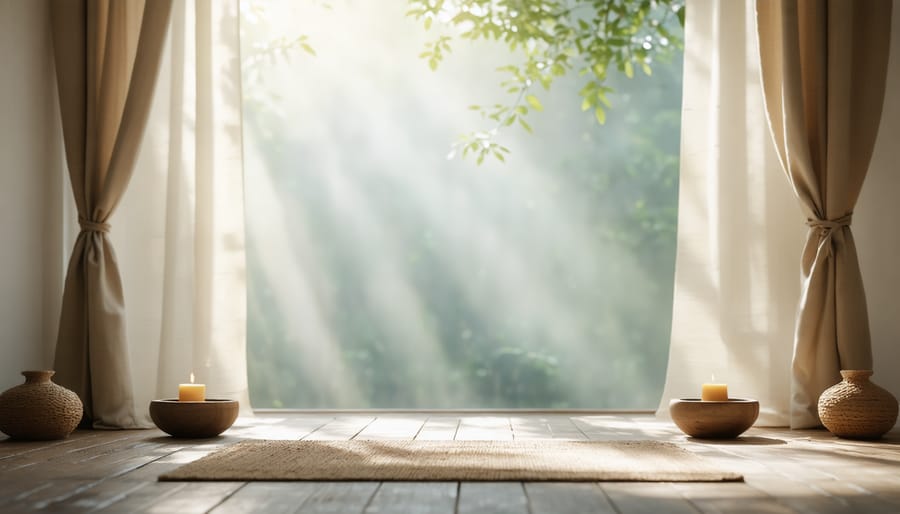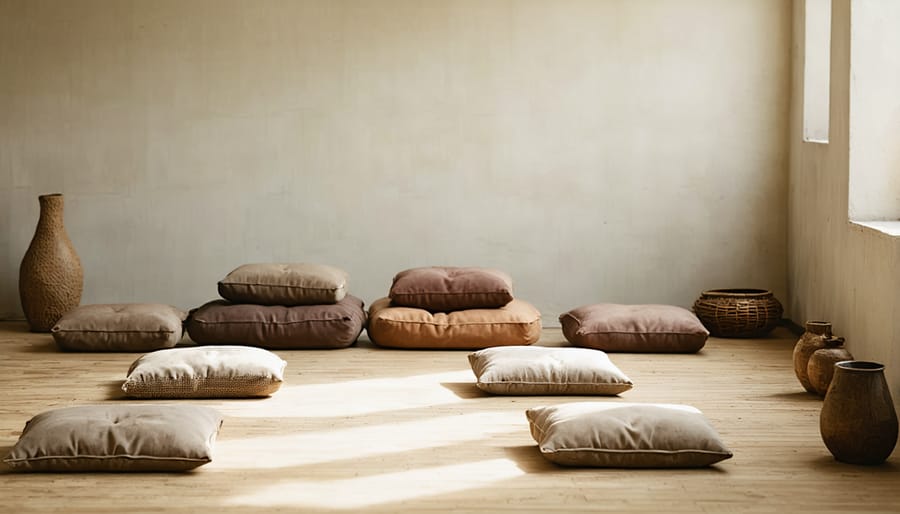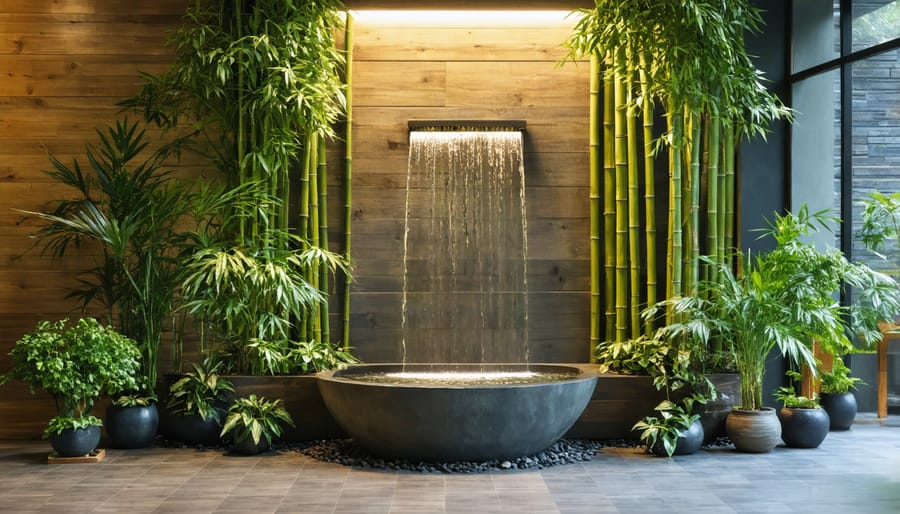Transform your living space into a serene sanctuary by incorporating natural materials, minimalist furniture, and soft, neutral colors that promote tranquility. Position floor cushions, meditation pillows, or a low-profile platform bed against an uncluttered wall to create a dedicated mindfulness area that anchors the room’s peaceful energy. Layer ambient lighting with paper lanterns, himalayan salt lamps, and dimmable LED strips to establish a calming atmosphere that transitions smoothly from day to night. Add living elements like bamboo plants, small indoor fountains, or a zen garden to engage the senses and foster a deeper connection to nature within your space. These foundational elements work together to create a balanced, harmonious environment where stress melts away and mindfulness flourishes.
Essential Elements of a Zen Meditation Room
Natural Light and Air Flow
Natural light and proper airflow are essential elements for creating a truly serene meditation space. Position your meditation area near windows whenever possible, as natural sunlight helps regulate your circadian rhythm and boost mood during practice. If you have multiple windows, experiment with different spots throughout the day to find the optimal lighting for your preferred meditation times.
Consider using sheer curtains or adjustable blinds to control light intensity while maintaining privacy. These window treatments allow you to modify the ambiance according to your needs – from bright and energizing in the morning to soft and calming in the evening.
For optimal ventilation, try to create a cross-breeze by opening windows on opposite sides of the room when weather permits. If natural airflow is limited, consider adding a small, quiet fan or air purifier to keep the space fresh and comfortable. Position these elements away from your immediate meditation area to minimize noise distraction.
During warmer months, you might want to incorporate indoor plants that naturally purify the air while adding to the room’s zen aesthetic. Just remember to choose low-maintenance varieties that won’t become a source of stress.

Minimalist Color Psychology
In creating a zen space, color plays a vital role in setting the right mood and energy. The key is to embrace mood-enhancing color schemes that promote tranquility and mental clarity. Start with a neutral base using soft whites, warm beiges, or gentle grays as your primary colors. These serve as a calming foundation that helps reduce visual noise and mental clutter.
For accent colors, lean towards earth tones and natural hues. Soft sage green can bring in elements of nature and promote balance, while pale blues echo the serenity of clear skies and still waters. Avoid bright, stimulating colors that might disrupt your meditation practice or relaxation time.
Consider incorporating natural wood tones through furniture or decorative elements – they add warmth without overwhelming the space. If you’re drawn to warmer tones, choose muted versions of terracotta or sand colors. Remember, less is more when it comes to color in a zen space. Stick to a maximum of three main colors to maintain visual harmony and promote a sense of peace and focus.
Mindful Furniture Selection
Meditation Cushions and Seating
Choosing the right meditation seating can make a significant difference in your practice and overall comfort. The traditional zafu (round cushion) and zabuton (flat mat) combination offers excellent support for longer meditation sessions. The zafu elevates your hips, helping maintain proper spine alignment, while the zabuton cushions your knees and ankles.
For beginners or those with limited flexibility, a meditation bench (also called a seiza bench) provides a comfortable alternative. These benches tilt slightly forward, reducing pressure on your knees and making it easier to maintain good posture without straining.
Consider memory foam cushions if you prefer modern options. They conform to your body shape and offer consistent support throughout your practice. Floor chairs with back support are another excellent choice, especially if you’re new to meditation or have back concerns.
When selecting your meditation seat, consider:
– Height (you want your knees below your hips)
– Firmness (firm enough for support, soft enough for comfort)
– Material (breathable fabrics like cotton or linen work best)
– Size (ensure it fits your body and space)
Remember, the best meditation seat is one that allows you to focus on your practice rather than physical discomfort. Don’t hesitate to test different options or use additional props like blankets and pillows to find your perfect setup.

Storage Solutions
In a zen room, thoughtful storage solutions are essential for maintaining that coveted sense of peace and tranquility. The key is to implement storage that’s both functional and aesthetically pleasing while making sustainable design choices whenever possible.
Consider incorporating floating shelves with clean lines, which provide practical storage while maintaining visual lightness. Built-in cabinets painted to match your walls create seamless storage that doesn’t interrupt the room’s flow. For meditation cushions and blankets, opt for beautiful woven baskets that add natural texture while keeping items easily accessible.
Multi-functional furniture is your best friend in a zen space. Look for ottomans with hidden storage, platform beds with built-in drawers, or minimalist benches that open up to store meditation accessories. Wall-mounted solutions, like sleek hooks for hanging items or slim cabinets for personal items, maximize floor space while maintaining the room’s peaceful atmosphere.
Remember to keep only essential items in your zen room. Use drawer organizers and small boxes made from natural materials to compartmentalize smaller items, ensuring everything has its place. This thoughtful organization helps maintain the clear, uncluttered energy that’s crucial for a meditation space.
Natural Elements and Textures
Plants and Water Features
Natural elements are essential in creating a peaceful zen atmosphere, and thoughtful indoor plant selection can transform your space into a serene sanctuary. Consider adding low-maintenance plants like bamboo, peace lilies, or snake plants, which not only purify the air but also bring a touch of nature indoors.
Position your plants at varying heights using simple bamboo stands or ceramic pots to create visual interest. A small tabletop water fountain can serve as a beautiful focal point while providing the soothing sound of flowing water. The gentle trickling helps mask outside noise and promotes relaxation.
For those with limited space, consider a wall-mounted water feature or a compact desktop fountain. Combine these with hanging plants or wall-mounted planters to maximize vertical space. Remember to choose plants that thrive in your room’s lighting conditions and maintain them regularly to keep your zen space looking fresh and inviting.
Mini rock gardens or sand gardens can also serve as meditative features, offering a hands-on way to practice mindfulness while adding natural texture to your space.

Sustainable Materials
Creating a zen space begins with choosing materials that respect both the environment and your wellbeing. Natural materials like bamboo flooring and reclaimed wood furniture emit fewer toxins and bring an authentic, earthy feel to your meditation space. Consider incorporating cork wall panels, which not only provide excellent sound insulation but are also sustainably harvested without harming trees.
For textiles, opt for organic cotton, hemp, or linen cushions and throws. These materials are grown without harmful pesticides and offer durability alongside comfort. Jute or sisal rugs add texture while being biodegradable and renewable. When selecting furniture, look for pieces made from certified sustainable wood or recycled materials – these choices often come with beautiful imperfections that add character to your zen room.
Natural clay or lime-based paints for walls release fewer VOCs (volatile organic compounds) and create a healthier indoor environment. For decorative elements, choose handcrafted items made from natural materials like stone, clay, or sustainably sourced wood. These thoughtful material choices not only support environmental consciousness but also enhance the peaceful, grounding atmosphere essential to a zen space.
Lighting and Atmosphere
Ambient Lighting Options
Lighting plays a crucial role in creating a peaceful meditation space, and the right ambient lighting can transform your zen room into a sanctuary of calm. Start with natural light by using sheer curtains or light-filtering blinds that allow soft daylight to flow in while maintaining privacy.
Layer your lighting with different sources at various heights. Consider installing dimmer switches to adjust the brightness according to your mood and time of day. Salt lamps and Himalayan salt wall sconces offer a warm, orange glow that’s particularly soothing for evening meditation sessions.
LED strip lights behind furniture or along crown molding can create a subtle, floating effect. Choose warm white or amber tones rather than cool blues to maintain a cozy atmosphere. Traditional paper lanterns and bamboo floor lamps add an authentic Asian touch while providing diffused illumination.
For a final layer, place flameless candles in strategic locations – they offer the peaceful ambiance of candlelight without safety concerns, perfect for longer meditation sessions.
Sound and Aromatherapy
Sound and scent play crucial roles in creating a truly immersive zen environment. Consider incorporating a small tabletop fountain or a white noise machine to generate gentle, flowing water sounds that mask outside distractions. Natural sounds like rainfall, ocean waves, or soft wind chimes can help transport your mind to a peaceful state.
For aromatherapy, use an essential oil diffuser with calming scents like lavender, sandalwood, or Japanese hinoki cypress. These fragrances can help reduce stress and enhance your meditation practice. Place himalayan salt lamps around your space – they not only provide soft, ambient lighting but also help purify the air.
Keep sound elements subtle; the goal is to create a gentle background ambiance rather than overwhelming the senses. Consider using bamboo wind chimes near a window for natural sound elements, or invest in a small meditation bowl for traditional singing bowl therapy.
Remember to refresh your aromatherapy scents seasonally to prevent sensory fatigue and maintain the space’s effectiveness.
Small Space Solutions
Don’t let a small space limit your zen aspirations! With smart maximizing small spaces strategies, you can create a peaceful sanctuary in even the coziest corners of your home. Start by choosing multi-functional furniture pieces, like a meditation cushion that doubles as floor seating or a folding screen that can both divide space and store items behind it.
Vertical space is your best friend in compact areas. Install floating shelves to display calming elements like small plants, crystals, or minimalist artwork without consuming precious floor space. Consider a wall-mounted fold-down table for meditation practices or tea ceremonies that can be tucked away when not in use.
Light colors and mirrors are essential tools for creating the illusion of space. Opt for soft, neutral tones on walls and choose furniture with clean lines and minimal bulk. Strategic mirror placement can reflect natural light and make your zen space feel twice as large.
Keep decor minimal but impactful. Choose one striking piece – perhaps a small water feature or a single stunning art piece – as a focal point. Use roll-up bamboo mats or meditation cushions that can be easily stored when you need more floor space. Remember, in zen design, less truly is more, making small spaces perfect for this minimalist aesthetic.
Creating your own zen room is more than just following design rules – it’s about crafting a personal sanctuary that speaks to your soul. By incorporating natural elements, choosing calming colors, maintaining minimalist principles, and adding mindful touches like aromatherapy and soft lighting, you can transform any space into a peaceful retreat. Remember, there’s no single “right way” to design a zen room. The key is to focus on elements that bring you tranquility and peace. Start small, perhaps with a corner of your bedroom or a quiet nook, and gradually build your perfect meditation space. Your journey to inner peace begins with that first step of creating your zen sanctuary. Take what resonates with you from these ideas and make them your own – your perfect zen space awaits.
